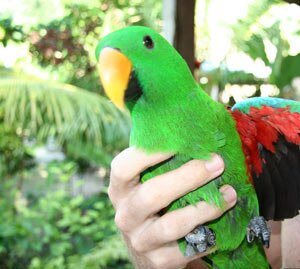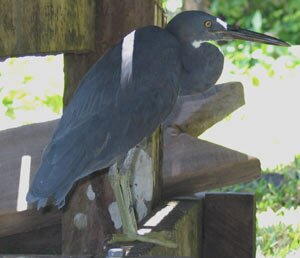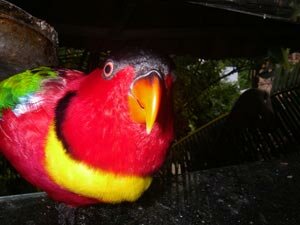
'Pipito'
Male Eclectus Parrot - kara mahi

'Pido'
Pacific Reef Heron - black phase - chou chinoko

'Pipito Jr'
Yellow-bibbed Lory - chiri
|
SOLOMON ISLANDS the wilderness lodge 8° 47´S ° 14´E
|
|
birding
|
|
The Solomon Island hosts one of the highest rates of avian endemism on Earth, with individual species and races unique to individual small islands. At Wilderness you have rainforest, coastal and oceanic habitats overlapping, providing a vast array of species in a very concentrated area. Every inch of land is covered with forest. From walking the adjoining lowland rainforests and coastal zones to following tuna schools just offshore from the Lodge, from walking the untouched Kavolavata River Valley to hiking the cloud forests of Mt Mariu, from visiting the seabird roosting sites on Malemale and Bulo Islands to boating up the mangrove and rainforest reaches of the Varea and Kumabusi Rivers, from early morning and evening stakeouts of the subsistence gardens to visiting the Karubelama Islands where thousands of frigate birds roost every night - there are so many birdwatching options at Wilderness, many within walking distance, and dozens of species visible from the Lodge. Given the lack of scientific [or amateur] scrutiny and the high degree of endemism, it is likely undocumented races and perhaps species exist on Gatokae and elsewhere in Marovo, with several variations in the Solomons archipelago already proving contentious in definitions of species vs. race and serving to illustrate the difficulties in applying arbitrary scientific categorisation in areas of such subtle and extremely localised diversity. The Myzomela and White-eyes are textbook examples of this cutting-edge of scientific categorisation. Wilderness has had very few [two at the time of writing] bird enthusiasts visit to date, and our local guides are still learning the English names of our birds. Our guides do, however, possess excellent bushcraft skills, and are very enthusiastic, with good English skills and we already have several prime birdwatching spots. They can take you as far and as long as you want to go, and we have a number of foot trails leading through all of the many different habitats on Gatokae, and where you can't reach by foot, they can take you by boat in most any weather. Wilderness hopes to build upon the list below to produce a definitive inventory of our avian neighbors, including Common, scientific, and Marovo names, and we are also engaged in dialogue with Conservation International and The American Museum of Natural History as conservation partners to facilitate the preservation of our unique birdlife through local awareness, research, and education. |
|
GUIDES & READING There is also Ernst Mayr's classic 'Birds of the Southwest Pacific', written 60 years ago, available in paperback over several reprints. Minimal graphics but definitive descriptions and background For sea and shore birds, Neville Coleman's 'Sea Birds and others of the Great Barrier Reef, Australasia. South Pacific, and Indian Ocean' is a compact guide with brief but very useful descriptions and excellent large format colour photos. Copy at Lodge. Another very useful reference, though with very few bird illustrations, and an inspiring read in itself due to it's overage of much of the flora and fauna of this area and it's cultural contexts, is 'Reef and Rainforest - An Environmental Encyclopedia of Marovo Lagoon, Solomon Islands' by Edvard Hviding and several Marovo contributors. This has been published by UNESCO under it's LINKS/CSI program as a vernacular curriculum reference for Marovo and is not commercially available but may be available from reference libraries. Many thanks to Edvard and his collaborators for use of this reference in compiling the tentative list below. Copy at Lodge. Another institutional publication which we have yet to view is D. Hadden's 'Birds of the North Solomons', Wau Ecology Institute, Papua New Guinea. Has been recently republished 4 as 'Birds & Bird Lore of Bougainville' by Dove Publications. For a thorough and inspiring study of endemism in birds of these islands, see Ernst Mayer & Jared Diamond 'The Birds of Northern Melanesia - Speciation, Ecology and Biogeography'. Lastly, a reference that has come up in bird lists for Guadalcanal - Bulletin of the British Ornithologists Club Gibbs, D. 6, Notes on Solomon Island Birds, Vol . , pp. 18-25. If anyone knows of other works dealing with birds specific or relevant to the Solomons, we would most appreciate your letting us know of the title and where it might be available! |
|
SPECIES The categories are loose groupings only and species ranges often overlap, reflecting the overlapping habitats we have here [for example dense tropical rainforest on tiny oceanic coral islands]. Should anyone have lists or positive IDs relevant to Gatokae or Marovo it would be very much appreciated if you could pass them on to us and they will be included in the list with credit and any other information. |
|
SEABIRDS (easily spotted around our three offshore islands and often viewable from the Lodge) |
|
COAST & SHORE BIRDS Solomon Sea Eagle - Haliaetus sanfordi - kakaka |
|
LAND & FOREST BIRDS Monarch - Monarcha sp - unidentified species Red-knobbed Fruit Pigeon - Ducula rubricera - kurukuru isu binga Eclectus Parrot - Eclectus roratus - kara [male (mahi) green with brilliant colours under wings, female [chiri] dark red and blue, often overflying Lodge] Vivoho- a Marovo term for several species of unidentified small songbirds of the forest - possibly leaf-warbler, flower-pecker, sunbird species |
|
'Pipito' |
'Pido' |
'Pipito Jr' |
|
The Usual Suspects - some of our tame, free-flying friends around the Lodge and house, not including Topi the hornbill and the tribe of Herons |
|
home |